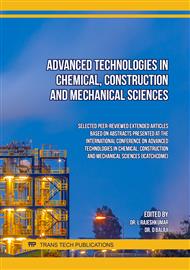[1]
A. Blatter, M. Maillat, S.M. Pimenov, G.A. Shafeev, A.V. Simakin, E.N. Loubnin, Lubricated sliding performance of laser-patterned sapphire, Wear, 232(1999)226–230.
DOI: 10.1016/s0043-1648(99)00150-7
Google Scholar
[2]
A. A. G. Bruzzone, H. L. Costa, P. M. Lonardo, D. A. Lucca, Advances in engineered surfaces for functional performance, CIRP Annals, 57(2008)750-769.
DOI: 10.1016/j.cirp.2008.09.003
Google Scholar
[3]
D. E. Kim, K. H. Cha, I. H. Sung, Design of surface micro-structures for friction control in micro-systems applications, CIRP Annals, 51(2002)495- 498.
DOI: 10.1016/s0007-8506(07)61569-8
Google Scholar
[4]
H.L. Costa, I.M. Hutchings, Hydrodynamic lubrication of textured steel surfaces under reciprocating sliding conditions, Tribology International, 40(2007)1227-1238.
DOI: 10.1016/j.triboint.2007.01.014
Google Scholar
[5]
I. Etsion, State of the art in laser surface texturing, Journal of Tribology- ASME, 127(2005)248-253.
DOI: 10.1115/1.1828070
Google Scholar
[6]
W. Yi, X. Dang-Sheng, The effect of laser surface texturing on frictional performance of face seal, Journal of Materials Processing Technology, 197(2008)96-100.
DOI: 10.1016/j.jmatprotec.2007.06.019
Google Scholar
[7]
S. Kunar, B. Bhattacharyya, Investigation into fabrication of microslot arrays by electrochemical micromachining, Machining Science and Technology, 23(2019)629-649.
DOI: 10.1080/10910344.2019.1575406
Google Scholar
[8]
S. Kunar, B. Bhattacharyya, Electrochemical microsurface texturing with reusable masked patterned tool, Engineering Science and Technology, an International Journal, 21(2018)1095-1108.
DOI: 10.1016/j.jestch.2018.08.001
Google Scholar
[9]
Y. Pan, Z. Hou & N. Qu, Improvement in accuracy of micro-dimple arrays prepared by micro-electrochemical machining with high-pressure hydrostatic electrolyte, International Journal of Advanced Manufacturing Technology, 100(2019)1767–1777.
DOI: 10.1007/s00170-018-2822-z
Google Scholar
[10]
X. Chen, N. Qu, H. Li, Z. Xu, Electrochemical micromachining of micro-dimple arrays using a polydimethylsiloxane (PDMS) mask, Journal of Materials Processing Technology, 229(2016)102-110.
DOI: 10.1016/j.jmatprotec.2015.09.008
Google Scholar
[11]
S. Kunar, E. Rajkeerthi, K. Mandal, B. Bhattacharyya, Fabrication of array of micro circular impressions using different electrolytes by maskless electrochemical micromachining, Manufacturing Review, 7, 15 (2020).
DOI: 10.1051/mfreview/2020012
Google Scholar
[12]
Z. Hou, N. Qu, X. Chen, Electrochemical micromachining of large-area micro-dimple arrays with high machining accuracy, J. Engineering Manufacture, 232(2018)1918–(1927).
DOI: 10.1177/0954405416682280
Google Scholar
[13]
J. Wang, W. Chen, F Gao, F. Han, Ultrasonically assisted electrochemical micro drilling with sidewall-insulated electrode, J. Engineering. Manufacture, 230(2016)466–474.
DOI: 10.1177/0954405414555740
Google Scholar
[14]
M.S. Park, C.N. Chu, Micro-electrochemical machining using multiple tool electrodes. J. Micromech. Microeng., 17(2007)1451–1457.
DOI: 10.1088/0960-1317/17/8/006
Google Scholar
[15]
S. Kunar, B. Bhattacharyya, Electrochemical micromachining of micro square pattern using reusable masked tool, Materials and manufacturing processes, 34(2019)487–493.
DOI: 10.1080/10426914.2018.1532582
Google Scholar
[16]
S. Kunar, Micro-electrochemical jet machining of large area microtexturing with tool movement strategy, Material and Manufacturing Processes, 37(6) (2021) 674-680.
DOI: 10.1080/10426914.2021.1962535
Google Scholar
[17]
S. Kunar, B. Bhattacharyya, Influence of various pulse waveforms during fabrication of micro rectangular pattern by masked tool using electrochemical micromachining, Journal of Advanced Manufacturing Systems, 20(1)(2021)27-50.
DOI: 10.1142/s0219686721500025
Google Scholar



